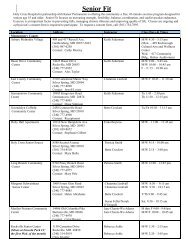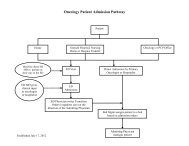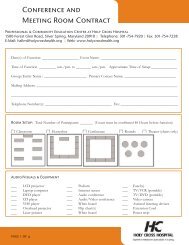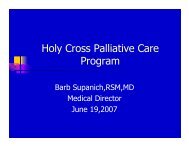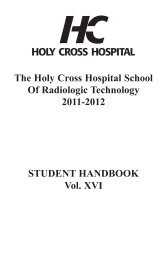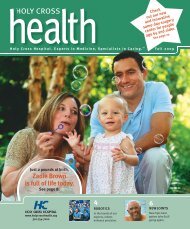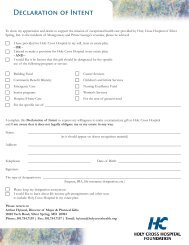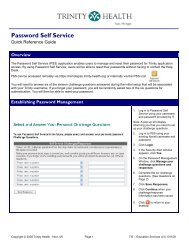Hope - Holy Cross Hospital
Hope - Holy Cross Hospital
Hope - Holy Cross Hospital
Create successful ePaper yourself
Turn your PDF publications into a flip-book with our unique Google optimized e-Paper software.
“Hoping for <strong>Hope</strong>”:Translating <strong>Hope</strong> Theory Into<strong>Hospital</strong>-Based Palliative Care PracticeTodd R. Cote MD, FAAHPM, FAAFPChief Medical Officer, Hospice of the Bluegrass and thePalliative Care Center of the BluegrassProgram Director, UK College of Medicine and Hospice of the BluegrassFellowship in Hospice and Palliative MedicineAssistant Professor, UK College of Medicine
Disclosure StatementDr Todd R. Coté has disclosed no relevantfinancial relationships.
Objectives1Discuss Nature and Definition of <strong>Hope</strong>2Review Three Current <strong>Hope</strong> Theories3 Examine <strong>Hope</strong>-Enhancing Clinical Interventions
The Nature and Definitionof <strong>Hope</strong>
“<strong>Hope</strong> is a mystery…..a human strugglebetween acting (the hoping for something)and being ( the lived experience of hope).Gabriel Marcel (1889-1973)
“Our shelves are bare. The journals aresilent.”Karl A. Menninger MD (1959 Keynote Speech on”<strong>Hope</strong>” to American Psychiatric Society)
<strong>Hope</strong> TheoryAn Interdisciplinary Approach?AnthropologyTheologyPhilosophyNursing/MedicineSociologyPsychology
<strong>Hope</strong> TheoryWhat is <strong>Hope</strong>?Psychologists GoalsMedicine/ Nursing Survival/CopingPhilosophers Attachment/Spiritual Virtue
“There appear to be no well-developedmeasures of a patient’s own sense ofhope.”Daniel P. Sulmasy MD, OFM, PhD (2002)
The Nature of <strong>Hope</strong> in Healthcare• <strong>Hope</strong> = Cure• <strong>Hope</strong> = A Tangible Treatment» Cripe LD (2006) <strong>Hope</strong> is the thing with feathers.JAMA 296:1815-6
<strong>Hope</strong> Theory• Currently:– No universal definition of <strong>Hope</strong>– A multitude of conceptual frameworks– Theories are diverse and divisive.» Nekolaichuk C.L. Diversity or Divisiveness? A criticalAnalysis of <strong>Hope</strong>. In : Essential Concepts in Nursing.Oxford: Elsevier (2005):179-212.
<strong>Hope</strong> in Clinical Practice• Evidenced- based literature review:– <strong>Hope</strong>: most important psychological factor in cancer patients( Nowotony1991, Miller 1992, Koopmeiner et al. 1997).– <strong>Hope</strong>: explored in newly-diagnosed cancer, cancer survivors , end stagedisease including HIV, ESRD and Heart Failure( Rustoen & Wikland 2000,Little& Sayers 2004, Hall 1990; Fleming 1997; Weil 2000; Benzein et al. 2000;Davidson et al. 2007).– <strong>Hope</strong>: contributes to improvement in QOL and coarse of illness(Stephensen 1991, Gottschalk et al. 1993, Farran et al. 1995).– <strong>Hope</strong>: positively linked to effective coping during chronic illness and firstrecurrence of cancer( Herth 2000, Kim et al. 2005).– <strong>Hope</strong>: leads to improvement in immune system function. (Udelman &Udelman 1985,1991).– <strong>Hope</strong>: Truth-telling and prognostication assist hopeful thinking for surrogatedecision makers and families in the intensive care unit in adults andpediatric patients. (Verhaeghe et al. 2007; Apatira et al. 2008; Mack 2006)– <strong>Hope</strong>: important to a meaningful life and dignified death in terminally illhomebound patients. ( Benzein et al. 2001)– <strong>Hope</strong>: lack of hope associated with increased depression and suicidalintent ( Beck et al. 1974, 1985, Chochinov et al. 1998 ).
<strong>Hope</strong> TheoryParticularizedSpecific, tangibleCognitiveThinking“Realistic <strong>Hope</strong>”Universal Attributes?GeneralizedLess tangibleEmotionalFeeling“Magic <strong>Hope</strong>”Dynamic ProcessDufault K, Martocchio B C. <strong>Hope</strong>: Its spheres and dimensions. Nursing Clinics of N A,(1985), 20, 379-391.
Three <strong>Hope</strong> Theories
<strong>Hope</strong> Theory Frameworks1) Snyder 2) NekolaichukParticularizedCognitiveUni-dimensionalGeneralizedEmotionalMulti-dimensional3) ScioliParticular/Generalized CombinationCognitive/Emotional/SpiritualMulti-dimensional
<strong>Hope</strong> Theory: Snyder Framework• <strong>Hope</strong> definition: The perceived capability to derivepathways to desired goals, and motivate oneselfvia agency thinking to use those pathways.• <strong>Hope</strong> is a positive motivational state that is basedon an interactively derived sense of successful:(a) agency (goal-directed energy)(b) pathways (planning to meet goals)• The trilogy: goals, agency and pathways» Snyder CR (2002) <strong>Hope</strong> Theory: Rainbows in the Mind.Psychological Inquiry 13:249-275.
<strong>Hope</strong> Theory: Snyder Framework• Goals: Those that anchortheir thinking about thefuture to specific goals aremore hopeful.• Agency: Those that arecapable of pursing goals ,who believe in their owncapacity, are more hopeful.• Pathway: Those that canimagine or plan ways toachieve goals step by stepalong a pathway) are morehopeful.AgencyGoalsPathways Snyder CR (2003) “<strong>Hope</strong> Theory: Rainbows in the Mind”, Psychological Inquiry 13:249-275.
HOPETHOUGHTSpathways(developmentallessons ofcorrelation/causality)+agency(developmentallessons of self asauthor of casualchains of events)EMOTIONSETOutcomeValuePATHWAYSTHOUGHTSAGENCYTHOUGHTSSTRESSOREMOTIONSEMOTIONSGOALattainment/nonattainmentSurpriseeventLearning History Pre-Event Event Sequence
<strong>Hope</strong> Theory: Nekolaichuk Framework• <strong>Hope</strong> Definition: associated with finding meaning inlife, taking risks in spite of uncertainty, andexperiencing credible and caring relationships.• People experience hope along three dimensions;– a) personal spirit– b) Risk– c) Authentic caring» Nekolaichuk CL, JevneRF, Maguire TO. (1999) Structuring themeaning of hope in health and illness. Social Science &Medicine, 48, 591-605.
<strong>Hope</strong> Theory: Nekolaichuk Framework• Personal Spirit: the personalexperience revolvingaround a core theme ofmeaning• Risk: the situationaldimension that ischaracterized byuncertainty• Authentic Caring: therelational dimension withunderlying themes ofcredibility and caring.RiskPersonal SpiritAuthenticCaring Nekolaichuk CL, Jevne RF, Maguire TO. (1999)Structuring the meaning of hopein health and illness. Social Science & Medicine, 48, 591-605.
UniversalUniversalityUniqueOne-dimensionalDimensionalityMultidimensionalTangibleIntangibilityIntangibleTime-boundTemporalityTime-freePredictablePredictabilityUnpredictableValuableValue-basedWorthlessRealisticReality-basedUnrealistic(Nekolaichuk CL. 2005 )
<strong>Hope</strong> Theory: Scioli Framework• <strong>Hope</strong> Definition: emotional circuits or networksunique to each person• People experience hope along four dimensions;a) Mastery: Goal-settingb) Survival; Coping, Terror Managementc) Attachment: Trust and Opennessd) Spirituality
<strong>Hope</strong> Theory: Scioli Framework• Mastery– Higher goals– Empowerment/Collaboration• Attachment– Trust– Openness• Survival– Coping Options– Self-Regulation• Spirituality– Faith– Cosmic MeaningHOPE
<strong>Hope</strong> Theory: Scioli FrameworkCourageSurvivalHeartAttachmentHOPEBrainMastery
Translating <strong>Hope</strong> Theory into<strong>Hope</strong> Enhancing Interventions in the<strong>Hospital</strong> Setting
Case Study 1When “<strong>Hope</strong>lessness” OverwhelmsDecision-Making.
Strategies for Healthcare Providers (Snyder)GoalsLet patient choosegoals.Assess goals onindividual basis.Encouragedeveloping alternativegoals.COMMUNICATERe-assessPathwaysHelp patient identifypathways , sub goals,obstacles.Provide interventionsfor cure, prolongation,improved QOL.Support thepatient/family’spathways.Work together withindividual, family andother healthcareproviders.AgencyDo all you can for painand symptommanagement.Encourage, support,be sensitive.Appropriate humor.Ask and remind of pastgoal successes.Gum A, Snyder CR, Coping with Terminal Illness: The Role of <strong>Hope</strong>ful Thinking, J Pall Med, (2002), 5:6, 883-894
Strategies for Patient/Family (Snyder)GoalsMourn losses of valuedgoals.Recognize one’sworth.Recall pastgoals/achievements/relationships.Develop alternativegoals important to self,communicate andenlist others help.Describe goals clearlyand measure progress.Enhance goals byagency and pathwaysPathwaysUse positive , activestrategies and activelyconfront.Believe in personalcontrol.Break goals into subgoals.Practice plans.Develop alternativepathways.Learn new skills.Communicate.Enhance by new goalsand agencyAgencyManage pain andsymptomsExerciseRestPlan during peak ofdayBe compliantExpect and plan fordifficultiesPositive, self –motivating talk.Develop social supportAppropriate HumorEnhance by new goalsand pathwaysGum A, Snyder CR, Coping with Terminal Illness: The Role of <strong>Hope</strong>ful Thinking, J Pall Med, (2002), 5:6, 883-894
Pursuitof Chosen GoalsDx of Life-threateningIllnessNew Goal:Search for Cure (unsuccessful)Snyder FrameworkAcceptance of dyingNew Goal:Prolong Life (Unsuccessful)Continue search for cureMourn lost goalsDevelop and Pursue Alternate GoalsDevelop PathwaystrategiesMaintain, IncreaseAgency StrategiesEnlist HelpInterdisciplinary Team
Strategies for Patient/Family (Nekolaichuk)ThemeCaringCommunicationCommitmentCopingCreatingCommunityQuestion for the patientTell me about a time in your life when youexperienced a moment of caring?Tell me about what it’s like to be ill?What might be one small thing that you do on aregular basis to help strengthen hope?What has helped you through difficult times in thepast?If you were to create a hope kit, what kind of thingswould you put in it?How is hope experienced in your community(culture)?CelebratingIf you were to plan a celebration of hope , then whatmight you do?Nekolaichuk CL, Jevne RF, (2003)
Case Study 2When “Unreasonable” <strong>Hope</strong>Guides Decision-Making.
“Unreasonable” <strong>Hope</strong>• Values (Religious Beliefs)– Divine Intervention > Your Knowledge– A Miracle ≠ Medical Prognostication• Survival– “When there is room for error , there is room forhope.”– “My cousin’s wife was told her baby was gonnadie , and now he’s 16 years old and playing football for high school. “• Denial– “The ultrasound/lab must be made a mistake!”
Impact of <strong>Hope</strong> on Decision-Making inthe ICUShared Decision-Making• Clinicians and patients/families can:1) Evaluate the options together in a systematic way.2) Consider the benefits and burdens of each treatment.3) Arrive at a clear and logical decisionChapman GB et al. Cognitive processes and biasesin medical decision making. Decision Making in Healthcare: Theory, Psychology, andApplication. Cambridge Univ. Press 2000, 183-210.
CognitiveDiagnosis/PredictabilityPrognosisSunk CostFuture Regret<strong>Hope</strong>Major Influences onDecision-Makingin ICUGoalsandDecisionsEmotionalFearPrior ExperienceAngerDenialValues/Religion/Spiritual<strong>Hope</strong>Chapman GB et al. Cognitive processes and biasesin medical decision making. Decision Making inHealthcare: Theory, Psychology, and Application.Cambridge Univ. Press 2000, 183-210.
Impact of <strong>Hope</strong> on Decision-Making inthe ICU“Titrating Guidance”• Clinician’s role in decision-making adapts over time to changes inthe patients state of health based on likelihood of recovery.• Five steps:1) Determine where (predictability of outcome/acceptable QOL)the patient is in the ICU.2) Identify the cognitive and emotional factors and preferences foroutcomes that affect the decision-making process of thepatient/family.3) Reflect on your own cognitive and emotional reaction todecisions.4) Acknowledge how these factors can be addressed inconversation.5) GUIDE the patient/family in creating a plan.Goldstein NE, Back AL, Morrison RS,Titrating Guidance: A Model to Guide Physicians in Assisting Patients and Family MembersWho are Facing Complex Decisions. Arch Intern Med (2008); 168(16): 1733-1739
Transforming <strong>Hope</strong> in the ICUOutcomeverydifficult topredictVery <strong>Hope</strong>ful<strong>Hope</strong>ChallengedPredictability of outcome“<strong>Hope</strong>less”OutcomeeasilypredictedDiminishing chance of returning to acceptable quality of life(Goldstein, Beck, Morrison, 2008)
Back to Case Study 2
Addressing “Unreasonable” <strong>Hope</strong> inDecision-Making• Clear , truthful , compassionate.• Acknowledge their faith.– “Test of faith”– “Guilt from God”– “Fear of church”– “Accepting Death also requires faith.”– “Not all miracles are ones that save lives.”• Have follow-up discussions.• Indentify your own frustration.• Use your resources. (Chaplain, Bereavementcounselor)• Focus on goals of care– Longevity, comfort, dignity?• Consider Limitation Contracts.• Transform <strong>Hope</strong>
The New Clinical Decision –MakingProcessPatient/FamilyEmotion/Cognitive/<strong>Hope</strong>ClinicalTeam andthe Patient/FamilyPredictableOutcome/Acceptable QOLGuidePlan of CareClinicianEmotion/Cognitive/<strong>Hope</strong>
Hoping….ForwardThank youtcote@hospicebg.org



